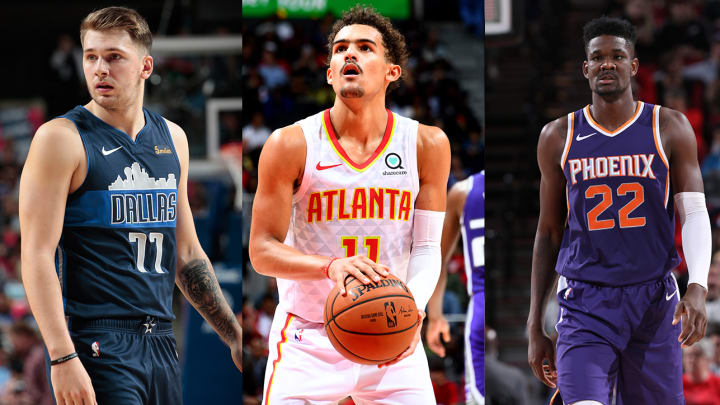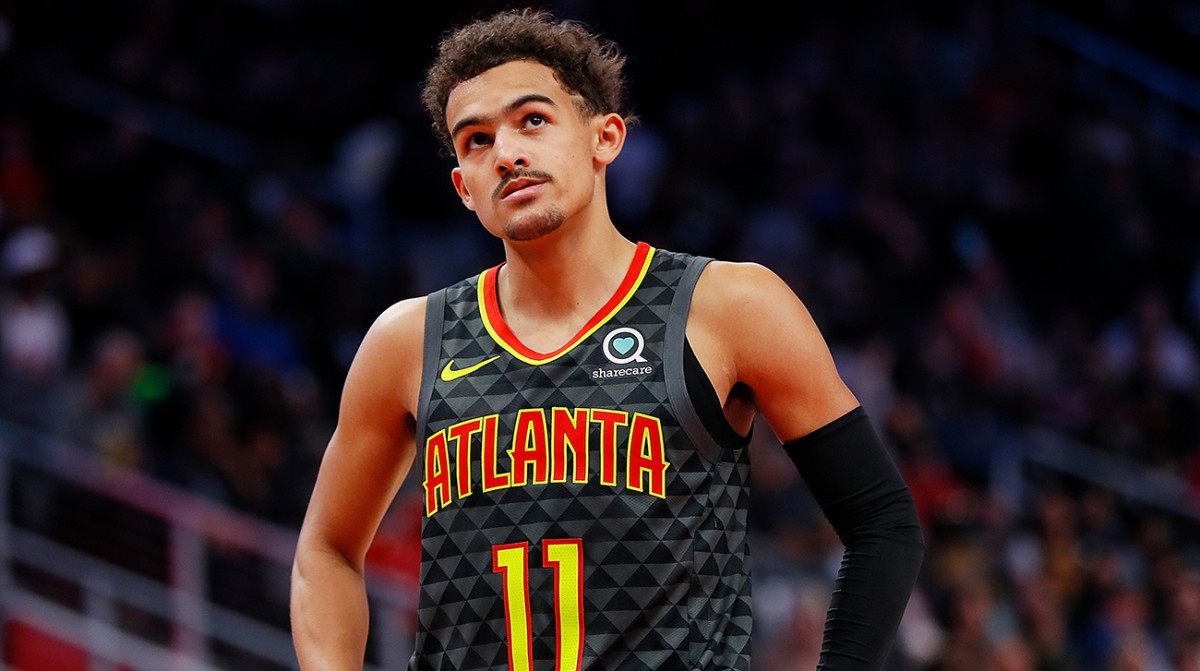NBA Rookie Report Cards: The Most Impressive Players After the First Month

Watching the 2018 rookie class evolve on the fly has been a nightly storyline as the NBA season hits the one-month mark. Discerning the quality of a draft and trying to slap a label on it tends to make little sense until its players begin to hit their second contracts (at the earliest), but the immediate returns have been largely positive. While few of the most prominent rookies from the 2018 draft are anchoring winning teams, many of them have looked the part as long-term pieces of the puzzle. Below you’ll find quick check-ups on some of the draft’s most promising names, in order of their draft slot.

Deandre Ayton, Suns (No.1)
The Suns have not been rescued by any means, but Ayton’s performance has largely been as advertised: he’s averaging a double-double (15.9 points and 10.6 rebounds entering Wednesday), he’s looked physically dominant, shown off his versatile offensive skill set and remains a defensive work in progress. Phoenix is not a good team, but its net rating has been 7.4 points better with Ayton on the floor, even though his shot blocking and rim protection could be stronger.
There have been some minor signs of disconnect—this week, coach Igor Kokoskov challenged Ayton to play with more urgency in a matchup with Anthony Davis, and Ayton didn’t quite seem to understand. But his learning curve looks to be a quick one, and it’s reasonable to think Ayton can continue as an impactful double double guy for a decade as his other skills expand. That’s the statistical baseline that made him a worthy top selection to begin with.
Marvin Bagley III, Kings (No.2)
While Sacramento has managed a surprising 8-6 start to the season, Bagley has made a nice impact coming off the bench. He probably hoped to be playing more than 22 minutes a night, but on a per-36 basis, he’s been close to double-double production, while also making a far more significant impact blocking shots than expected. Bagley’s role in Duke’s zone last season may have hidden some of his rim-protection capabilities.
It will be hard to assess whether he’s truly a future superstar until the Kings decide to turn him loose, and Sacramento has tended to slow-play things with their young guys in recent years, for better or worse. It’s unclear at this stage if he’s really a guy you can run a lot of offense through. The inarguably positive news is he looks like he belongs, but after being drafted at No. 2—ahead of a handful of equally talented players—expect Bagley’s trajectory to be nitpicked a bit. His role should increase as the season goes on.
WOO: Zion Williamson Tops 2019 NBA Draft Big Board Rankings
Luka Doncic, Mavericks (No.3)
Doncic has been stellar, but hasn’t quite fixed the Mavericks, who enter Wednesday at 5–8 and are probably another year away from the playoff picture. He’s not a rookie in the regular sense after all the years he spent as a pro overseas, and Doncic leads all members of his draft class with 19.6 points per game. He’s posted excellent shooting splits of 47.4, 38.6 and 75.9%, continued the all-around production that made him the best player in Europe last year and is probably the early front-runner for Rookie of the Year honors.
His primary area of improvement is taking care of the ball—Doncic is averaging 4.4 assists to 4.1 turnovers—which points to his ongoing adjustment to the speed of the NBA game. His ability to process the floor has long been considered his special skill, and we can reasonably expect that to improve down the line. Nobody should be doubting his acumen anymore.
Jaren Jackson, Grizzlies (No.4)
It remains puzzling that Jackson spent so much time on the bench for Michigan State last season, particularly given how well he’s fit into the league from day one. His defensive impact has been tangible, and he’s earned a starting job for a Memphis team that’s hovered above the .500 mark and looks to have escaped the disaster that was 2017–18 with some semblance of identity intact.
Jackson is still fouling too much, and his three-point shooting hasn’t fully translated yet, but he’s come on a bit lately, posting his first double-double and adding five blocks on Monday. His ability to face up and attack the basket has been impressive and adds a necessary component that sets his overall ceiling as high as anyone in this class. Jackson’s rookie growing pains have predictably been more pronounced than some of his older, more experienced counterparts, but it looks like the Grizzlies struck gold, and he might be the player who eventually leads the transition into the post-Gasol era.

Trae Young, Hawks (No. 5)
Andrew Sharp gave us an excellent deep-dive into Young’s rookie year thus far, and the public has quietly caught on to just how good he’s been. Young has already proven that on some level, the quality of his play at Oklahoma is going to be sustainable. For the Hawks, the fact that he’s made their draft-night swap wholly defensible is a major boon.
While his three-point shooting has been streaky for the most part, Young’s speed and remarkable passing instincts have proven a viable combination at this level already. He will always be a player who gives up something on the defensive end, but Atlanta now finds itself in an advantageous position with clear financials and the opportunity to build a team to cover for Young’s weaknesses—and more importantly, amplify his strengths. With five double-digit assist games under his belt, things are trending upward, and the Hawks will be patient as Young develops.
Mohamed Bamba, Magic (No. 6)
Bamba’s nightly impact has varied, but Orlando has won each of the three games in which he’s scored in double figures, his shot-blocking presence is evident and his minutes have often been productive. He’s played less than 20 minutes on most nights, but the Magic understand the long view. Nikola Vucevic has been terrific at center thus far, and until he moves, Bamba’s training wheels will presumably stay on, but there have been enough fascinating flashes to remain enthused about his long-term future. Stay tuned.
Wendell Carter, Bulls (No.7)
As expected, Carter took advantage of the opportunity created by Chicago’s key frontcourt injuries and has entrenched himself as a valuable piece of the team. He’s been especially steady in November and particularly impressive on the defensive end, shining outside of the zone Duke deployed his freshman year and making a difference as a shot-blocker. Carter has done nothing to shake the widely-held perception that he was one of the safest picks in the draft, and showing up in terrific shape has done wonders for his game. The Bulls will not be good anytime soon, but Carter should be a starting-caliber player for a long time—how much his offense can expand will be a big factor in where his ceiling eventually lies.
WOO: 25 College Teams NBA Fans Should Care About This Season
Collin Sexton, Cavaliers (No. 8)
Sexton has already been scrutinized more heavily than most rookies, cast as the target of veteran teammates’ ire in various reports and looking like a bit of a risky choice at No. 8 based on what we’ve seen. To be absolutely fair, the things he’s been criticized for (selfish play and lack of defensive acumen) were both noticeable flaws in his game at Alabama. That he was drafted eighth overall is less a knock on him than it is a case of misevaluation by the Cavs, particularly as Shai Gilgeous-Alexander has begun to blossom for the Clippers.
There’s a chance he will end up best as a third guard than a starter due to his shoot-first tendencies, but again, it’s only been 13 games, and Sexton deserves as much a chance to improve as anyone. This is a transition year for Cleveland, with veterans to offload, a coaching change already in the rearview and a total lack of stability all-around. Sexton will probably deserve a mulligan, but the pressure will mount going forward as the Cavs chart their post-LeBron future beneath the specter of his lofty selection.
Shai Gilgeous-Alexander, Clippers (No. 11)
There’s not a rookie who’s undergone a more stunning series of metamorphoses over the past 365 days than Gilgeous-Alexander, who went from overwhelmed freshman to offensive fulcrum at Kentucky, established himself as a lottery talent and now looks underdrafted after a series of impressive showings for the Clippers. He has earned a starting role this month, and has inarguably become the most valuable asset going forward for a franchise that could look drastically different this summer.
Gilgeous-Alexander’s creativity off the dribble, all-around nose for the ball and high-level poise for his age have established him as L.A.’s franchise cornerstone for the time being, and his unselfishness and defensive ability will allow him to play with just about anyone going forward. Granted, this is November, but there’s a chance the Clippers netted the lottery’s biggest steal.
WOO: USC's Kevin Porter Jr. Deserves Your Attention
Miles Bridges, Hornets (No. 12)
Watching Bridges earn minutes on a veteran-heavy roster has been impressive, and his play has assuaged some of the concerns about his NBA fit. He’s a good case of someone who has strongly benefitted from the way the league has changed—while he’s somewhere between a three and a four skill-wise, Bridges is athletic enough that his ability to do a bit of everything splits the difference and allows him to blend different lineups to an effective degree. He’s shot the ball respectably from three, turned in some eye-popping dunks and increasingly become a factor for Charlotte. The Hornets’ situation looks far more promising after a month of play, and Bridges is part of the reason why. He may not create shots well enough to be a star, but he does enough to help the team that he should be a useful piece.
Mitchell Robinson, Knicks (No. 36)
Landry Shamet (No. 26) and Bruce Brown (No. 42) have been solid in legitimate roles for the Sixers and Pistons, respectively, but Robinson has been the obvious late-draft home run at this point. That he slipped to 36 is a bit of a travesty. Still, there was a reasonable leaguewide hesitance to attach Robinson to a first-round contract based on the uncertainty inspired by his career decisions, and the teams picking ahead of the Knicks in the second round all drafted centers in the first, save for Dallas. New York at that point was making a low-risk, high-reward move, and Robinson has rewarded them by leading qualified rookies in blocks-per-36 minutes. He’s not doing much offensively yet, but there’s a clear chance he pans out. After Sunday’s nine-block showing, there’s some real intrigue here.
Allonzo Trier, Knicks (Undrafted)
Credit the Knicks for being thrifty in recent seasons, with Trier joining Ron Baker, Damyean Dotson and Robinson as interesting finds. There was not a whole lot of reason to believe in Trier at Arizona—he didn’t play much defense, shot the ball too much and his teams underachieved—but his ability to score was always evident and the Knicks have allowed him to do that. If there was one role he could fill right away, it was “tertiary scorer on a bad team,” and New York has gotten good results. Time will tell if Trier’s style of play can actually help a high-end rotation, but it’s not fair to hate too hard given what he’s proven so far.
